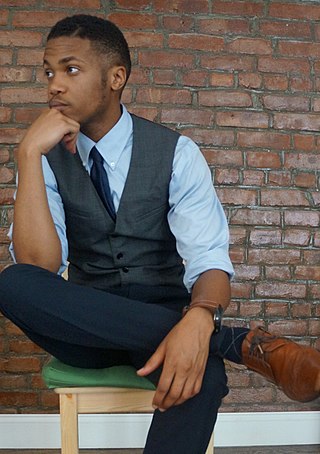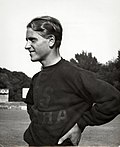Top Qs
Timeline
Chat
Perspective
Trans man
Man assigned female at birth From Wikipedia, the free encyclopedia
Remove ads
Remove ads
A trans man (short for transgender man) is a man who was assigned female at birth. Trans men have a male gender identity, and many trans men undergo medical and social transition to alter their appearance in a way that aligns with their gender identity or alleviates gender dysphoria.[1]

Transition among trans men can involve a variety of social, medical, and legal steps. Initially, the term referred specifically to those undergoing hormone replacement therapy (HRT) or sex reassignment surgery (SRS),[a] but its meaning has expanded to include psychological development and self-acceptance. While some trans men pursue medical interventions like hormones and surgery, others may opt out due to personal choice or financial constraints. Many who do not undergo top surgery use chest binding, and some employ packing to create a masculine shape. Transitioning can include social changes, such as adopting a new name and pronouns, legal name change or other document updates, and medical transition with HRT or surgery. Achieving social acceptance as male may be challenging without physical transition, and some trans men may selectively present as female in certain situations. Additionally, some transmasculine individuals may choose to become pregnant, give birth, and breastfeed.
Estimates of the prevalence of trans men in the U.S. vary widely, from 1 in 100,000 to 1 in 2,000. Census data for 2015 show around 58,000 name changes indicative of transition to male, though far fewer changed their sex coding. Trans men, like cisgender men, have diverse sexual orientations, with most identifying as heterosexual, but others as queer, pansexual, bisexual, or gay. Many trans men have past connections with the lesbian community, often identifying as butch lesbian before recognizing their transgender identity. While some date heterosexual or queer women, trans men face more challenges integrating into cisgender gay men’s communities, which tend to be more body-focused. However, research challenges assumptions that trans men are predominantly heterosexual, showing a majority of non-heterosexual identities and rising acceptance within gay communities.
Remove ads
Terminology
Summarize
Perspective




The umbrella term trans[b] is a shortening of both transgender and transsexual, and describes anyone whose gender identity does not align with their assigned sex.
The term transsexual originated in the medical and psychological communities, and is generally considered a subset of transgender, although the two are not always interchangeable. It predominantly describes people with medically diagnosed gender dysphoria, and who desire to permanently transition to the opposite sex via sex reassignment therapy. Many trans people prefer the labels transgender or trans, considering them more inclusive and less stigmatizing.[2][3] However, others, such as Buck Angel, reject the label of transgender.[4][5] The GLAAD media reference guide advises against describing people as transsexual, except for individuals who explicitly identify as such.[6]
Transmasculine (sometimes clipped to transmasc) is a broader term for all trans individuals with predominantly masculine identities or gender expression, and includes trans men as well as non-binary people who were assigned female at birth and may have an identity that is partially masculine but not entirely male.[7][8]
The alternate spelling transman is sometimes used interchangeably. However, like transwoman, it is often associated with trans-exclusionary views which hold that trans men are distinct from men, and thus require a separate word to describe them.[9] For this reason many transgender people find the spelling offensive.[9]
Another common term for trans men is female-to-male (FTM or F2M),[10] but this is considered outdated by some, in part because it confuses sex and gender, or because someone may be nonbinary and lie somewhere on the spectrum between the two extremes, neither of which accurately describes them.[11]
Remove ads
Transitioning
Summarize
Perspective


Originally, the term trans men referred specifically to female-to-male transsexual people who underwent hormone replacement therapy (HRT) or sex reassignment surgery (SRS),[a] or both. The definition of transition has broadened to include theories of psychological development or complementary methods of self-acceptance.[12][13] Many of those who identify as transgender face gender dysphoria.
Transsexual and transgender men may seek medical interventions such as hormones and surgery to make their bodies as congruent as possible with their gender presentation. However, many transgender and transsexual men cannot afford or choose not to undergo surgery or hormone replacement therapy.
Many who have not undergone top surgery choose to bind their breasts. There are a few different methods of binding, including using sports bras and specially made binders (which can be vest-type, or wrap-around style). Tape or bandages are often depicted in popular culture.
Some trans men might also decide to pack, to create a phallic bulge in the crotch of clothing. However, this is not universal. Trans men who decide to pack may use anything from rolled up socks to specially made packers, which resemble a penis. Some packers are also created for trans men to be able to urinate through them (stand-to-pee, or STP, devices), or for sexual penetration or other sexual activity (known as "pack-and-play").
Transitioning might involve some or all of the following steps:[14][better source needed]
- Social transition: using a preferred name and pronouns, wearing clothing seen as gender appropriate, disclosure to family, friends and usually at the workplace/school.
- Sex reassignment therapy: hormone replacement therapy (HRT), and/or surgery (SRS)[15]
- Legal affirmation: name and (sometimes) sex marker correction in legal identification documents.[16][17]
Being socially accepted as male (sometimes known as passing) may be challenging for trans men who have not undergone HRT and/or surgery.[16][17] Some trans men may choose to present as female in certain social situations (e.g. at work).[16][17] After physical transition, trans men usually live full-time as male.[16][17] However, some transmasculine individuals might choose to use and engage their bodies to be pregnant, birth a baby, and breastfeed.[7][18]
Remove ads
Prevalence, identity and relationships
Summarize
Perspective
In the United States, the ratio of trans men within the general population is unclear, but estimates range between 1:2,000 and 1:100,000.[19][better source needed][20][21][better source needed] A U.S. Census Bureau study in 2015 suggests that there were around 58,000 name changes in census records consistent with female to male transitions although only 7,500 of these changed their sex coding as well.[22][failed verification]
In a study by Kara Devaney, entitled Transgender Research Literature Review, it is addressed that the term transgender encompasses a myriad of different and unique identities that do not follow the "normal" rules of gender. [citation needed]Miriam J. Abelson writes, "There is no question that trans men's experiences are men's experiences and give insight about men, masculinity, and gender inequality."[23]
Like cisgender men, trans men can have any sexual orientation or sexual identity, including heterosexual, gay, bisexual, and queer,[24] and some trans men consider conventional sexual orientation labels inadequate or inapplicable to them.[25] The literature commonly indicates that sexual attraction to those of their same gender (e.g., trans men liking men and trans women liking women) is considerably less common among trans men than among trans women; the majority of trans men are reported as heterosexual.[26][27] Surveys from the National Center for Transgender Equality show more variation in sexual orientation or sexual identity among trans men. In NCTE's 2015 Transgender Survey of respondents who identified as trans men, 23% identified as heterosexual or straight. The majority (65%) identified their sexual orientation or sexual identity as queer (24%), pansexual (17%), bisexual (12%), or gay/same-gender loving (12%).[28]
Some trans men date heterosexual women, while other trans men date queer women; the latter might be because queer women are less invested in the gender and sexual anatomy of a person when it comes to selecting an intimate partner.[27] It is also common for trans men to have histories with the lesbian community or to feel that they identify better with that community because of its wide acceptance of gender variance, with a number of trans men having previously identified as lesbian (often as a "butch lesbian") before realizing that they are instead transgender.[26][27][29]
Trans men have less success integrating socially within cisgender gay men's communities, which tend to be more body-focused, especially in terms of being phallocentric.[27][30][31] Yitzchak et al. state that, as a result, they more commonly see gay trans men partnering with each other than with cisgender gay men.[27] There are, however, cases of women being likelier than men to thoroughly question trans men about their motivations for modifying their bodies.[30]
Some scholars argue against assumptions that trans men are predominantly heterosexual and usually have lesbian histories. In scholars Dan Irving and Rupert Raj's book Trans Activism in Canada, researchers state, "There is still a common misperception that trans men are largely heterosexual amongst those who conflate gender identity and sexual orientation. It is frequently assumed that trans men are exclusively attracted to women and have lesbian histories prior to transition." They add, "Recent data from the Trans PULSE project (Bauer, Redman, Bradley, & Scheim, 2013) challenge this assumption, with 63 percent of female-to-male spectrum trans people in Ontario reporting non-heterosexual identities and/or past-year sex with trans or non-trans men." They also argue that, based on some research, "many non-trans gay men have welcomed trans men into gay communities and have increasingly recognized trans men as potential sexual and romantic partners."[32]

Remove ads
Health
Summarize
Perspective
Trans men and transmasculine people often face difficulty and discrimination receiving medical treatment, due to both bias against assigned-female patients and against transgender people. In the 2015 U.S. Transgender Survey, 42% of 8,037 trans men reported negative experiences with healthcare providers.[28] There is a lack of credible research about how to provide adequate healthcare to transmasculine people undergoing medical transition, notably with doctors having difficulty diagnosing breast cancer in people who have undergone top surgery.[33] HIV infection between trans men and others is still increasing.[34]
Reproductive health
Trans men with an intact female reproductive system may become pregnant.[35]: 1 [36] According to surveys compiled by Medicare for Australia, 75 male-identifying parents gave birth in Australia in 2016, and 40 in 2017.[37] Although testosterone therapy eventually induces amenorrhea in most trans men, trans men with uteri are still at risk of pregnancy even if they no longer have periods. Additionally, trans men are likely to live in poverty and have inadequate access to healthcare, so many do not have access to the contraceptives they may want or need. Trans men can use barrier methods, oral contraceptives, IUDs, and other methods of contraception while taking testosterone.[38]
Testosterone use is contraindicated while attempting to conceive, while pregnant, and while breastfeeding, because high levels of testosterone during pregnancy can cause fetal abnormalities, specifically with the urogenital system of a female fetus.[38]
Trans men experience issues during pregnancy not experienced by pregnant women. For example, trans men may experience discrimination on the base of their gender while receiving obstetric care. Many providers are unfamiliar with the needs of transgender patients. Additionally, some men report that being pregnant made their gender dysphoria worse.[39]
Remove ads
Sports
Summarize
Perspective
Trans men in women's sports
Early Examples
Early known examples of trans men who competed at international levels were intersex men who were raised as girls, competed in women's championships, and came out as men later in life. They include Zdeněk Koubek, an intersex man who was Czech women's national champion and medal winner at the 1934 World Women's Athletic games in track whose awards and records were later revoked;[40] Willy De Bruyn, a Belgian cyclist who became unofficial women's world champion in 1934, born intersex and raised as a girl but later identified as a man;[41] and French sprinter Pierre Brésolles, who ran the women's 100 metre and 200 metre races and won third place in the women's 100 meter dash in the Oslo European Championship in 1946.[42][43]
Another notable early trans man athlete is Andreas Krieger (b. 1965), an East German shot putter who competed on the women's East German athletics team at SC Dynamo Berlin in the 1980's. Krieger was unknowingly doped with large doses of anabolic steroids, which masculinized his body, influencing his decision to transition in the 1990's. He is now involved in anti-doping activism.[44][45][46]
Recent Examples
Keelin Godsey competes women's hammer throw and holds the NCAA Division III record.[47][48] In 2008, he became the first openly transgender athlete to compete for a spot on the United States Olympic team.[49][50][51] Another Olympic team athlete, former member of Japan's Olympic women's fencing team from 2004 to 2006 Fumino Sugiyama, is now a transgender rights activist and works to promote acceptance and participation of trans athletes in Japanese sports.[52]
In basketball, noted trans men include Jay Mulucha, an LGBTQI activist and Ugandan basketball player with the Magic Stormers in the Federation of Uganda Basketball League (FUBA), and American basketball player Kye Allums, the first openly transgender NCAA Division I college athlete.[53] Harrison Browne was the first openly transgender athlete in professional American hockey, coming out in 2016 and transitioning medically after his retirement from professional sports in 2018.[54] Kumi Yokoyama is a Japanese footballer who plays as a forward for women's football club Okayama Yunogo Belle and the Japan women's national team.[55][56]
Safety concerns
In 2017, high school state wrestler and trans boy Mack Beggs won the Texas state girls' wrestling title.[57] Beggs began taking testosterone to transition in 2015, which other athletes argued gave him an unfair advantage and created a safety risk. He reached the state championship tournament after two opponents forfeited matches due to safety concerns, and a lawsuit was filed to suspend Beggs because of testosterone use. Beggs' mother stated that he wanted to compete in the boys' competition but was barred due to rules requiring that athletes compete according to the sex on their birth certificate.[58][57]
Transgender men athletes in women's sports
- Harrison Browne, Canadian ice hockey player
- Zdeněk Koubek, Czech intersex man who was a women's track champion (1936)
- Jay Mulucha, Ugandan basketball player
- Witold Smętek, Polish intersex man and track competitor (in white) (1934)
- Kumi Yokoyama, Japanese professional soccer player
Trans men in men's sports
In 2013, Schuyler Bailar was recruited to the Harvard women's swimming team. He took a gap year after high school to transition, and was told he could join the men's or women's swim team at Harvard, according to his preference. He joined the men's team, and in 2015 Bailar became the first publicly documented NCAA D1 transgender man to compete as a man in swimming.[59][60]
More recently, Chris Mosier, a duathlon and triathlon competitor on the US National team in duathlon, successfully challenged the International Olympic Committee former policy that required surgery before transgender athletes could compete in the category that matched their gender identity.[61][62][63] Mosier's challenge led to the creation and adoption in 2016 of new IOC guidelines for the categorization of transgender athletes in the Olympics in World Championships.[64][65][66]
In 2018, American Patricio Manuel became the first trans man to compete in professional men's boxing.[67][68]
Transgender men athletes in men's sports
- Schuyler Bailar, men's swimmer for Harvard from 2015 to 2019
- Chris Mosier, men's triathlete, duathlete and racewalker
- Patricio Manuel, American professional boxer who competed in men's boxing after transition
Trans men in mixed sex sports
Quince Mountain was the first transgender dog musher to compete in the Iditarod dogsledding race in 2020.[69]
Remove ads
Discrimination
Transgender men can face discrimination as a result of their status as trans men. Such discrimination may include sexual violence.[70]
See also
Notes
- The term sex reassignment surgery was initially used, but this is now generally known as gender-affirming surgery (GAS) or gender-confirmation surgery (GCS)
- occasionally spelled trans*, using the asterisk (
*) as a wildcard character
References
Further reading
External links
Wikiwand - on
Seamless Wikipedia browsing. On steroids.
Remove ads








